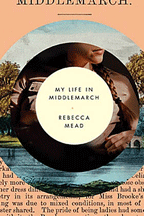Exclusive interview with author Rebecca Mead and a review of her new book about living her life through the pages of George Eliot’s literary classic Middlemarch
Rating: 3 Stars
by Gabrielle Pantera
 “I had always loved George Eliot and Middlemarch: A Study of Provincial Life, which I first read at 17 and have read about every five years since,” says My Life in Middlemarch author Rebecca Mead. “When I reached my early forties I wanted to explore more closely what this book had meant to me over those many years, and what it still had to say to me.”
“I had always loved George Eliot and Middlemarch: A Study of Provincial Life, which I first read at 17 and have read about every five years since,” says My Life in Middlemarch author Rebecca Mead. “When I reached my early forties I wanted to explore more closely what this book had meant to me over those many years, and what it still had to say to me.”
Mead’s analysis of Middlemarch is insightful and will inspire you to reread (or perhaps read for the first time) Eliot’s Middlemarch. If you love literature and Middlemarch in particular, this book is for you.
Part biography, part reporting, this book reveals Mead learning about Eliot and her own life. Mead’s book mirrors Middlemarch in theme and feeling. Her book started as an article for The New Yorker, for which she is a staff writer.
As a teen Rebecca Mead was studying for her O-levels to get to Oxford when she first the book, regarded by many as the greatest English novel. Virginia Woolf described Middlemarch as “the magnificent book that, with all its imperfections, is one of the few English novels written for grown-up people.”
We see Mead as she moves to America and becomes a journalist, dates, marries and has children. There are some similarities between Mead’s and Eliot’s life. Through all that she rereads Middlemarch many times, which proves something of a compass in life.
While Mead’s research is thorough, what’s missing is how the characters and book impacted Mead. There is lots of correspondence and visits to places where Eliot spent time but it would have been instructive to know why she reread that book at those times in her life and how precisely it changed (or did not change) who she is. It would have been great to hear Mead’s thoughts and motives after rereading Middlemarch with real life examples of the effect the book had on her.
George Eliot was not the author’s real name. Nor was the author even a man. Mary Anne Evans, later Marian Evans, wrote Middlemarch as her seventh novel. She started writing it in 1869. Life intruded and she stopped writing to help care for the dying son of her companion George Henry Lewes. She started writing again in 1871–72 and the novel was serialized. In 1874 the first one-volume edition was published. The themes in Eliot’s book are largely about education and self-delusion.
“The Penguin paperback of Middlemarch was on back order on Amazon because demand had risen,” says Mead. “That’s very gratifying to see. Its been fascinating to me that so many readers have gone back to read Middlemarch, either after reading my book or in preparation for reading it.”
Mead says she was surprised that her book was featured on the front page of the New York Times book review and was reviewed there by Joyce Carole Oates. As is well documented in the book, Mead did extensive research. “I read letters, journals, notebooks of George Eliot, books about her, and I traveled to the places she had lived and written. And I traveled back to my own childhood home, too. The manuscript of Middlemarch is in the British library and I was fortunate enough to be given access to it. Amazing. I also went in the archives of Yale university and the New York public library.”
Mead was born in London and is now based in Brooklyn, New York.
My Life in Middlemarch by Rebbeca Mead • Hardcover, 304 pages, Publisher: Crown (January 28, 2014), Language: English • ISBN-13: 978-0307984760 $19.08
[adrotate group=”8″]
